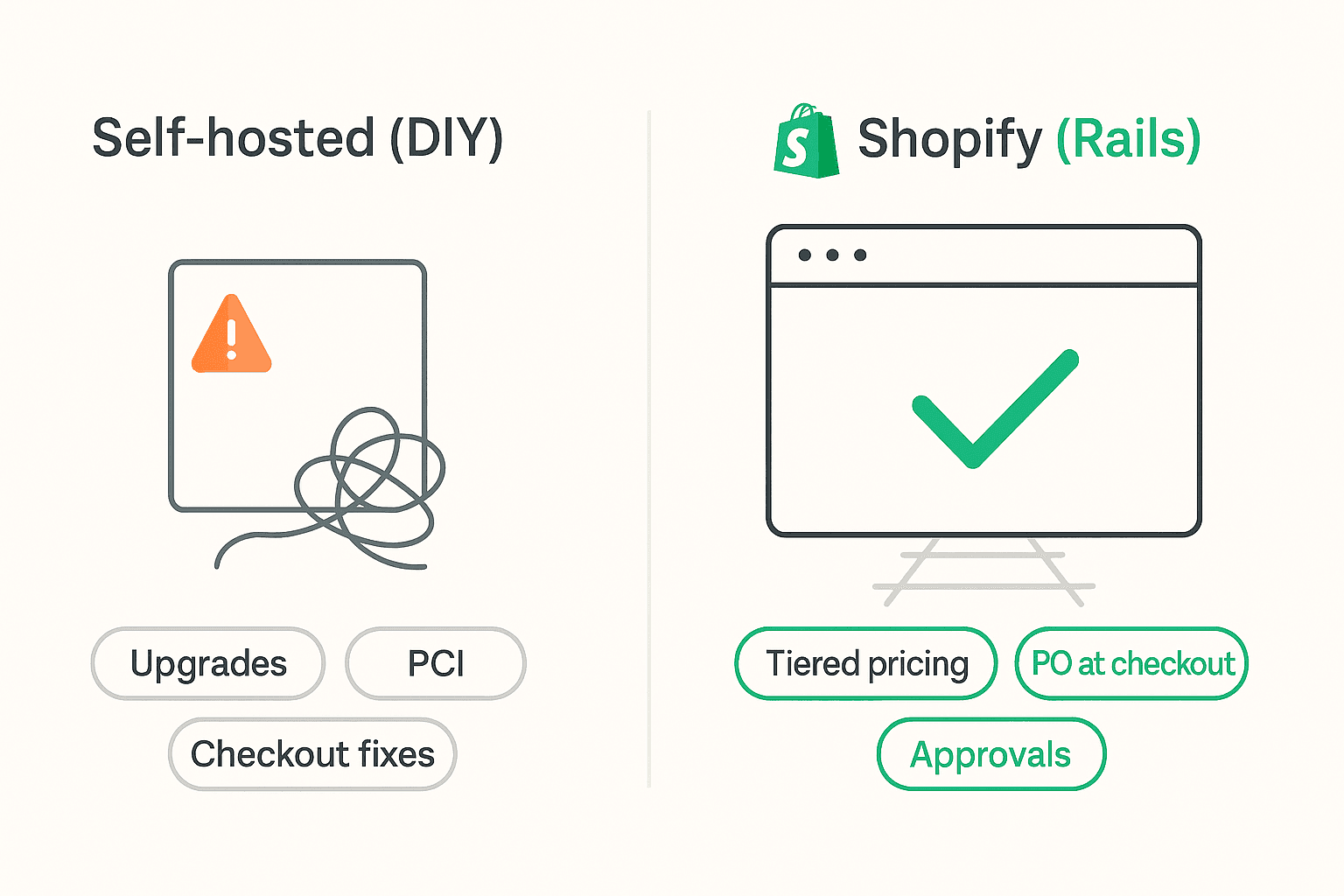Friday, 6:40 p.m. Your sales head drops a bomb on Slack: “Can we open wholesale next month? Tiered pricing, PO at checkout, simple approvals.”
You’ve got two paths:
Stand up a platform you can sculpt like clay—then spend the next twelve weeks arguing with upgrades, PCI, and a checkout that keeps breaking.
Or pick a system that comes with rails, move fast on what matters, and accept that you won’t be allowed to modify every molecule.
Nine times out of ten, we choose the rails. That’s Shopify.
What you’re actually buying
You’re not buying “a theme” and “some apps.” You’re buying freedom from babysitting servers, hotfixing WAF rules, and prepping for PCI audits. You’re buying a world where a marketer can ship a landing page without booking a developer. And when the work does need code—tiered discounts, shipping math, cart validation—you’re buying a governed way to extend the platform without forking the core or creating your own upgrade tax.
The result isn’t glamorous; it’s calm. Calm during sale spikes. Calm when you add a new catalog. Calm when Finance asks, “Why don’t refunds match payouts?” and you can actually reconcile them.
Why it wins in messy reality
The first win is speed. Shopify lets non-devs move layouts, content, and promotions while engineers tackle the handful of custom rules that make you money. The second win is the marketplace—not because “there’s an app for everything,” but because you can borrow proven blocks for subscriptions, search, and loyalty, then replace them with code only when the payback is obvious. The third win is checkout: you don’t reinvent payments or stability; you add precisely what you need at defined extension points and stop there.
And when you outgrow a theme, you don’t throw the store away. You go headless—on the same data—without inventing your own hosting puzzle. That’s the mature path, not a religion.
The moments it doesn’t fit
There are honest no-gos. If your edge is a completely bespoke checkout and you’re unwilling to spring for Plus, don’t fight the guardrails. If every price needs a live contract calculation across three systems before it renders, you’ll be frustrated by governed extension points. If you want to control infra for strategic reasons—data gravity, proprietary SLAs—go self-hosted and embrace the ops tax with eyes open. And in some regions, payments math (third-party fees, gateway features) can break your TCO; model it.
The hidden taxes no one puts on a comparison chart
Unlimited freedom feels great until quarter three, when upgrades meet customizations and your sprint turns into a merge marathon. Shopify is deliberately opinionated so upgrades don’t eat your roadmap. That constraint is a feature.
App sprawl is the other silent killer. Teams install “just one more” plug-in until the storefront slows and margins erode. Our rule: prove value in 30 days or uninstall. When an app becomes mission-critical and pricey, we replace it with a small, focused extension—only if the payback is under eight months.
Finally, data. Most stacks leak refunds, mis-attribute revenue, and leave Finance reconciling spreadsheets at midnight. On Shopify, we standardize events and tie payouts to orders and returns so a CFO can trust a single “truth” table. That’s the line between marketing spend and marketing bets.
A quick sniff test
Don’t score features; score outcomes. If you nodded “yes” to most of these, you’re in Shopify country:
You need revenue in 8–12 weeks, not 8–12 months.
Marketing and merch will ship changes weekly without asking Engineering’s permission.
Your discount/shipping/validation rules are complex but describable (i.e., spec-able and test-able).
Guardrails at checkout sound like safety, not a cage.
B2B is in scope and you can budget for Plus when needed.
Headless is a later decision, not day one bravado.
Your ERP/OMS can be a “good API citizen.”
Predictable cost beats surprise infra bills.
“App first, then replace with code when justified” is acceptable.
You want a calendar of experiments, not a calendar of maintenance.
If that describes your world, Shopify keeps you moving.
A humane 90-day plan
Weeks 1–2: Lay foundations. Pick a fast theme. Model products and metafields with tomorrow’s bundles in mind. Cap yourself at 5–7 essential apps and write a performance budget on day one.
Weeks 3–6: Wire the money logic. Implement the few Functions that matter (discounts, shipping, validation). If you’re doing B2B, enable companies, catalogs/price lists, and payment terms. Wire ERP/OMS with clear failure handling and replay queues.
Weeks 7–10: Make checkout and growth deliberate. Add only the UI extensions you truly need. Instrument analytics properly (events spec + server-side tagging). Start CRO work on navigation, search, PDP structure, and trust cues.
Weeks 11–13: Build scale habits. Load-test the paths customers actually use. Automate the back office with Flow (alerts, tagging, approvals). Audit apps: keep, replace with code, or remove.
The decision that respects your future self
If you value velocity, governance, and predictable ops, Shopify is the sensible default. You’ll still write code—right where it creates advantage—and you’ll do it without incurring an upgrade hangover every quarter. If your moat is deeply custom commerce mechanics, own a platform you can reshape top to bottom. Just price the steady state, not the demo.




